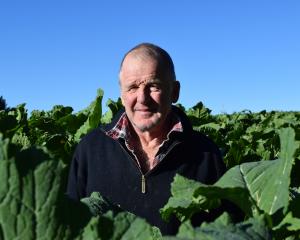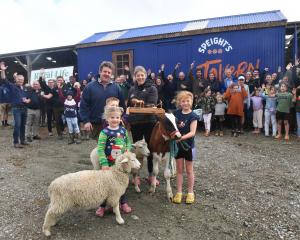
Shawn McAvinue joined a workshop in Maniototo to find out why veterinarian Dave Robertson wants farmers to stop "smashing" their sheep with drench and start using it in a more sustainable way.
Farmers need to act now to curb an "explosion" of drench-resistant parasites, a southern vet says.
About a dozen farmers attended a Beef + Lamb New Zealand workshop in Wedderburn last week.
The Wormwise workshop was promoted as explaining the effects of drench resistance and the tools available to make informed choices for more sustainable management of parasites in a farming system.
Wormwise central South Island facilitator Dave Robertson, a vet from Veterinary Centre Oamaru, looks at pasture in a different way.
A dewy paddock sparks images of thousands of parasite larvae inside droplets on pasture.
Patchy cocksfoot pasture "screams worms to me".
"The thatchy bits are housing parasite larvae."
Farmers had been relying on drench to reduce the "worm burden" in their sheep for decades.
A natural interaction between host and parasite was a "thing of the past" because "we keep smashing them with drench".
Drench resistance was when a drench was less than 95% effective.
The problem was becoming more common, increasing across all drench types and combinations, and posed a real risk to the viability of sheep farming.
He wanted farmers to "get out of the mindset of having to drench all the time" and start using drench in a sustainable way.
The rate of drench-resistant parasites being traded across New Zealand had reached an "alarming level" in the past two years.
"We’ve talked about quarantine drenching for years but its a real reality now."
No new drench products were being developed to combat drench resistance.
"As the drench companies have become more globalised and corporatised, the big markets are cat and dog flea treatments — they’re not interested in developing another sheep drench."
The Wormwise programme was launched in 2008 and had a recent "resurgence" due to more farmers running drench-resistant sheep.
His motivation for being part of the programme was because healthier animals were at the core of any good farm business, Mr Robertson said.
"If that means less drench or better feeding, then I’m all for it."
Drench sales spiked at this time of the year, despite it being the time when there was the least amount of worms on pasture.
The reason being, farmers were preparing to reduce the worm burden to stop "ewes falling to pieces over lambing".
Parasite larvae needed moisture to live so they thrived in dewy conditions, such as autumn and spring.
The life-cycle of a parasite dictated why vets told farmers to have a 21-day drenching interval.
When the larvae was eaten by a sheep, it took 21 days to mature to an adult in a sheep’s gut — mating, exchanging genetics and becoming drench resistant — its parasite eggs starting a new cycle in sheep dung.
In a dewy conditions, when temperatures were 10degC or hotter, it took a week for the egg to hatch and became a larvae for a sheep to eat and start the cycle again.
"That’s why you see an explosion of parasites in the spring."
When grass was green, 5% of the worm population lived in sheep and the rest lived in the environment.
The dry conditions in Maniototo reduced the amount of worms in the environment, resulting in a higher proportion of worms living in sheep, compared to a wet environment.
"There’s a lot of drench resistance in this patch because of our dryland conditions."
When it was dry, parasite larvae burrowed into the subsoil to survive.
"You’ll never get rid of them— they’ll always find somewhere to hide."
Larvae were generally found on the bottom 2cm of a grass sward or in the first 1cm of soil.
When grass was short and sheep were pushing down into the hatch to eat, they would be eating more larvae.
If sheep were given feed other than grass, such as lucerne, they would eat fewer worm larvae.
"It’s very hard for a parasite larvae to climb up a lucerne stalk."
Drench-resistant sheep performed on lucerne and swede, kale and fodder beet because it did not include worms.
Studies revealed lambs drenched every 21 days which ate "wormy" grass grew at two-thirds the rate of an undrenched lamb grazing on areas of a farm with a low parasite level.
"Lambs need clean pastures with low parasite levels to do well."
A drenched sheep ate more feed than one which had not been drenched.
Parasites caused inflammation in a ewe’s gut and decreased nutrient absorption.
Killing a gut of worms in a ewe with drench allowed it to absorb up to 20% more protein to perform, such as developing a foetus and udder.
When a ewe was adequately fed it had the ability to kill 90% of the larvae in its gut.
Consequently, well-fed ewes could clean up some of the parasites in a paddock.
Adult sheep had greater immunity to parasites and a greater ability to fight disease than younger sheep.
Farmers finishing lambs in the same paddock back-to-back was a common farming practice but should be avoided.
"Lambs on lambs is pretty standard and the drenches aren’t working — the larval challenge goes through the roof and things start to fall to bits. When we’ve got ewes going in behind those systems, it’s made a huge difference."
The ewes following the lambs should be left enough feed to graze for a maximum of four days to be able to drop some of their parasite genetics.
Beef cattle also played an important part in cleaning up parasites from pasture, he said.
"If you regrow the pasture, and brought some cattle through — that’s perfect integration."
A sustainable alternative to drenching all your sheep was using the refugia tool.
Refugia was keeping some non-resistant worms on the farm by avoiding drenching some of the healthier sheep, such as ewes caring for a single lamb.
Ideally, refugia would result in non-resistant larvae outnumbering resistant larvae on pasture.
He recommended farmers use an effective drench and some level of refugia.
"That’s the key to sustainable drench use."
The effectiveness of your drench would dictate the level of refugia necessary.
Farmers needed to create a refugia flock now, he said.
"Leave 10% of a mob — or your singles — just start somewhere."
Some farmers made a refugia mob of the "dry" ewes carrying no lambs at scanning.
"Others have a mob of mixed-aged wethers to do the job."
The flock should be tagged and their performance monitored at tailing and weaning.
"You’ll start getting more comfortable with the concept of leaving ewes undrenched."
After weaning, the refugia ewes could be run with lambs for a month.
He knew of farmers who had been running a refugia mob for six years.
Some farmers were including between 2% and 5% of their lambs in their refugia mob.
The undrenched lambs "fall to bits", but the farmers were willing to accept production loss for the greater good of the mob.
He ran a trial on hill country two-tooth ewes, in which he gave a drench capsule to a third of the ewes "pre-tup", or before being put out to the ram, a third of the ewes were given a capsule before lambing and the remaining third were given no drench.
All of the ewes weighed 50kg when they went to the ram.
At scanning time, the ewes given a capsule pre-tup weighed 58kg and the rest weighed 50kg.
By weaning, every ewe weighed 58kg.
The trial raised a question about ewes drenched pre-tup.
Where was the feed those ewes were eating between scanning and weaning going.
"Did they put it into their lambs, did they milk better?"
The farmers sold the lambs as store before weaning weights could be checked, so the question remains unanswered.
Farmers at the meeting took home some insights from the workshop.
Farmer Paulette Duncan, of Becks, said she had a small refugia mob and the workshop highlighted it needed to be bigger.
"We need to do a whole lot more."
Farmer Liam Dowling, of Wedderburn, said from the workshop highlighted the importance of rotating types of stock to reduce the worm burden in irrigated paddocks.
Farmer Tim Elder, of Waipiata, said pasture management, such as the benefits of lucerne, and the life-cycle of a worm was the biggest insight from the workshop.
Farmer Daniel Adam, of Wedderburn, said as a result of the workshop, he would focus more on running a refugia mob and would reduce the number of drench capsules he used.
"I’ll cut back a bit."















